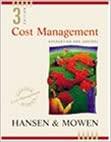Loring Chemical Products Division produces surfactants, ingredients used in producing laundry detergents. (Surfactants are the components that
Question:
Loring Chemical Products Division produces surfactants, ingredients used in producing laundry detergents. (Surfactants are the components that help release soil from clothing.)
It is possible to make different types of surfactants, depending on the nature of the raw material input. One possibility, for example, is the use of beef tallow as the primary raw material input. Another possibility is to use petrochemical stock as the primary raw ma¬
terial input. The primary input plus other inputs and energy sources are used to produce the surfactants. An inventory analysis produces the following for the production of sur¬
factants:

The greater water usage for tallow relates to the requirement that water must be used to produce feed for beef. The cost per kilogram of petrochemical stock is $0.40. The cost per kilogram of tallow is $0.60. Water costs $0.50 per kilogram and energy is $1.20 per kilowatthour. When air contaminants exceed 5 per 1,000 kilograms, pollution control equipment must be purchased and installed. The cost of acquiring and operating this equipment is $500 per five units of contaminants. Liquid contaminants are more trouble. If dumped into local streams over the life cycle, the costs are estimated to be $120 per unit of liquid contaminant.
If a water treatment system is used, the cost is $60 per unit of contaminant. Finally, soil cleanup is estimated at $20 per unit of solid residue.
Required:
1. Assess the relative environmental impacts of the two approaches to producing surfac¬
tants using only operational environmental measures. Which of the two approaches would you recommend? Justify your choice.
2. Use the cost information and calculate an environmental impact cost per 1,000 kg of surfactants. Which of the two approaches would you now recommend? Does the life cycle cost approach have limitations? Explain.
3. Which parts of the life cycle described by the inventory analysis are controlled by the supplier? By the producer? What part of the inventory analysis is missing?
Step by Step Answer:

Cost Management Accounting And Control
ISBN: 9780324002324
3rd Edition
Authors: Don R. Hansen, Maryanne M. Mowen





